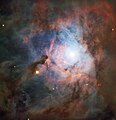File:The Birth of the Hunter.jpg

原始檔案 (1,705 × 1,767 像素,檔案大小:708 KB,MIME 類型:image/jpeg)
摘要
| 描述The Birth of the Hunter.jpg |
English: The constellation of Orion (The Hunter) is one of the most recognisable collections of stars in the night sky. We have noted Orion’s prominent stars for tens of thousands of years at least, and likely far longer. Chinese astronomers called it 参宿 or Shēn, literally “three stars”, for its three bright dots (which form the Hunter’s belt). The ancient Egyptians regarded it as the gods Sah and Sopdet, manifestations of Osiris and Isis, respectively, whereas Greek astronomers saw a brave hunter — the eponymous Orion — with his sword above his head, ready to strike.
Mythology aside, Orion is a fascinating patch of sky. This image, from ESO's Very Large Telescope, shows a reflection nebula nestled at the heart of the constellation — NGC 2023. Located close to the well-known Horsehead and Flame Nebulae, NGC 2023 lurks about 1500 light-years away from Earth, and is one of the largest reflection nebulae in the sky. Reflection nebulae are clouds of interstellar dust that reflect the light from nearby or internal sources, like fog around a car headlight. NGC 2023 is illuminated by a massive young star named HD 37903. The star is extremely hot — several times hotter than the Sun — and its bright blue-white light causes NGC 2023’s milky glow. Such nebulae are often the birthplaces of stars, and contain a clumpy distribution of gas that’s significantly denser than the surrounding medium. Under the influence of gravity, these clumps attract one another and merge, eventually creating a new star. In a few million years time, Orion's Belt may gain a new star! The image was taken with the VLT’s FORS (FOcal Reducer and Spectrograph) instrument as part of the ESO Cosmic Gems programme. This initiative produces images of interesting and visually attractive objects using ESO telescopes, for the purposes of education and outreach. The programme makes use of telescope time that cannot be used for science observations. All data collected may also be suitable for scientific purposes, and are made available to astronomers through ESO’s science archive.Italiano: La costellazione di Orione (The Hunter) è uno degli asterismi più riconoscibili nel cielo notturno. Gli astronomi cinesi lo chiamarono 参 宿 o Shēn, letteralmente " tre stelle ", per i suoi tre punti luminosi (che formano la cintura del cacciatore). Gli antichi egizi lo consideravano come gli dei Sah e Sopdet, rispettivamente le manifestazioni di Osiride e Iside, mentre gli astronomi greci videro un coraggioso cacciatore - l'omonimo Orione - con la spada sopra la testa, pronto a colpire.
Mitologia a parte, Orione è un affascinante angolo di cielo. Questa immagine, dal Very Large Telescope dell'ESO , mostra una nebulosa a riflessione incastonata nel cuore della costellazione. Situata vicino alle Nebulose Testa di Cavallo e Fiamma, NGC 2023 dista circa 1500 anni luce dalla Terra, ed è una delle più grandi nebulose a riflessione nel cielo |
| 日期 | |
| 來源 | https://www.eso.org/public/images/potw1919a/ |
| 作者 | ESO |
授權條款
 |
This media was created by the European Southern Observatory (ESO).
Their website states: "Unless specifically noted, the images, videos, and music distributed on the public ESO website, along with the texts of press releases, announcements, pictures of the week, blog posts and captions, are licensed under a Creative Commons Attribution 4.0 International License, and may on a non-exclusive basis be reproduced without fee provided the credit is clear and visible." To the uploader: You must provide a link (URL) to the original file and the authorship information if available. |
此檔案採用創用CC 姓名標示 4.0 國際授權條款。
| |
說明
創用CC姓名標示4.0國際 繁體中文 (已轉換拼寫)
13 5 2019
檔案歷史
點選日期/時間以檢視該時間的檔案版本。
| 日期/時間 | 縮圖 | 尺寸 | 使用者 | 備註 | |
|---|---|---|---|---|---|
| 目前 | 2024年2月14日 (三) 15:22 |  | 1,705 × 1,767(708 KB) | C messier | full size |
| 2019年5月13日 (一) 08:39 |  | 1,280 × 1,327(195 KB) | Jmencisom | User created page with UploadWizard |
檔案用途
下列頁面有用到此檔案:
全域檔案使用狀況
以下其他 wiki 使用了這個檔案:
- el.wikipedia.org 的使用狀況
- en.wikipedia.org 的使用狀況
- eu.wikipedia.org 的使用狀況
- vi.wikipedia.org 的使用狀況
詮釋資料
此檔案中包含其他資訊,這些資訊可能是由數位相機或掃描器在建立或數位化過程中所新增的。若檔案自原始狀態已被修改,一些詳細資料可能無法完整反映出已修改的檔案。
| 製作/提供者 | ESO |
|---|---|
| 來源 | European Southern Observatory |
| 簡稱 |
|
| 影像標題 |
|
| 使用條款 |
|
| 資料產生的日期時間 | 2019年5月13日 (一) 06:00 |
| 使用軟體 | Adobe Photoshop CC 2018 (Windows) |
| 檔案修改日期時間 | 2019年1月10日 (四) 22:34 |
| 數位化的日期時間 | 2018年5月1日 (二) 12:20 |
| 詮釋資料最後修改日期 | 2019年1月10日 (四) 23:34 |
| 原始文件唯一識別碼 | xmp.did:2f00b251-73db-dd48-a2f8-badd7e262d4f |
| 關鍵字 | NGC 2023 |
| 聯絡資訊 |
Karl-Schwarzschild-Strasse 2 Garching bei München, None, D-85748 Germany |
| IIM 版本 | 4 |

